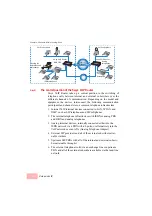
Voice over IP
1-5
• Quality of Service/traffic management
The term Quality of Service (QoS) embraces a range of func-
tions in your SwyxConnect. QoS functions consider the power-
ful classification methods used by firewalls (e.g. restriction to
subnets, individual workstations or certain services). These
enable Quality of Service to be very precisely controlled.
By guaranteeing a minimum bandwidth, precedence can be assi-
gned to enterprise-critical applications, VoIP telephony or cer-
tain user groups.
Details about the functions of the SwyxConnect stateful-inspection
firewall are available in the reference manual.
1.4
Voice over IP
The term Voice over IP (VoIP) refers to voice communications over
computer networks based on the Internet protocol (IP). The core idea
is to provide the functions of traditional telephony via cost-effective
and wide-spread networking structures such as the Internet. VoIP
itself is not a standard, rather it is a collective term for the various
technologies (equipment, protocols, voice encoding, etc.) which
make voice communications in IP networks possible.
1.4.1
Example Applications
Voice over IP solutions offers advantages across a broad spectrum of
applications, starting with small companies and extending to large
corporations with extensive networks of subsidiaries. In the following
section, we will demonstrate a number of examples.
Detailed information about configuration is available in the chapter
'Configuration of VoIP functions' or in the LCOS reference manual.
1.4.1.1
Supplementing existing PBXs
VoIP functions can be conveniently added in to existing telephone
structures by using a Swyx VoIP Router. The Swyx VoIP Router is
simply connected between the public exchange line (e.g. ISDN
NTBA or analog telephone line) and the PBX.
Summary of Contents for SwyxConnect 1722
Page 112: ...I 5 ...














































